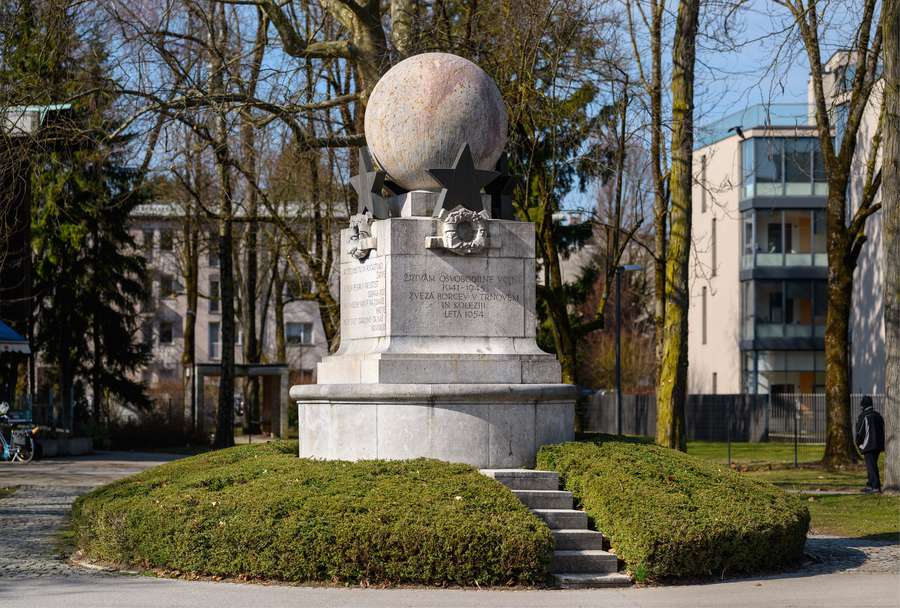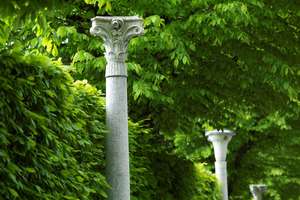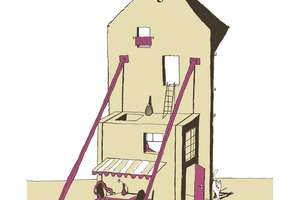Plečnik’s monuments to the National Liberation Struggle
The architect Jože Plečnik devoted part of his creative oeuvre to the design of monuments, the most numerous among them being commemoration plaques and monuments to the fallen in World War II. His work on them began on the initiative of Ferdo Kozak, the minister of culture at the time.
The topic of the monument to the National Liberation Struggle became at that time one of the central missions of his school at the Faculty of Architecture, with Plečnik collaborating with students on a number of monuments. As a nationally conscious Slovene, Plečnik emphasised the nation’s independence and supported the Liberation Front, with World War II leaving a deep personal scar on him. In Plečnik’s office at the faculty, the commemorative plaque to the students fallen in the war, Plečnik designed it in 1946, can still be seen today.
Plečnik’s oeuvre includes as much as 25 completed monuments and commemorations to the National Liberation Struggle; five are in Ljubljana, while the others are scattered throughout Slovenia, from Vipava to Črna na Koroškem. Plečnik was known for not charging anything for his designs, which naturally resulted in an abundance of requests. The monuments’ clients – mostly local associations of war veterans – usually repaid Plečnik and his students, who helped with the work, with homemade brandy, wine, potatoes, firewood, or coal.
We can typologically divide Plečnik’s monuments to the National Liberation Struggle into four categories, but all of them are recognisable by their originality, innovation in form, often usage of local materials, and special attention to their spatial placing and circumstances. Plečnik used solely architectural elements, while he integrated the official symbols of the time, especially the five-pointed star, in a subordinated manner.
Most often, Plečnik's erected monuments are columns or block-shaped, and their context ties into votive monuments from the past. We can recognise a large amount of student work in them, as they were most often straightforward projects and we know of several variations for a single project. The second monument type are roofed sheds, which are transfigurations of pre-war chapels or even mausoleums. The third type of monuments are fountain-shaped: just a few of them were ever realised with many never leaving the planning stage. Fundamentally, it is a fountain for the town’s centre, with water serving as the symbol of living memory. Certainly, the most interesting Plečnik monuments are those that are the most original, without any precedents in history. These were designed with pure architectural elements; cylinder, cube, block, sphere. One of the most inventive monuments is situated near the Plečnik House in Trnovo; in one of the design solutions for this one, Plečnik inscribed the monument with, “It will work out, it always does”.
Colophon
Exhibition production: Muzej in galerije mesta Ljubljane, represented by Blaž Peršin, Director, Turizem Ljubljana, represented by mag. Petra Stušek, Director iand MOL, Oddelek za kulturo, zanj mag. Mateja Demšič.
Curator: Ana Porok
Photographs: Miran Kambič
Archive photographs: MGML documentation / Plečnik Collection
Project management and text editing: Maja Kovač
Proof reading: Katja Paladin
Translation: Matic Šavli
Graphic and exhibition design: Jaka Šuln
Location
T +386 1 280 16 04 (reception)
T +386 1 241 25 06
E plecnik@mgml.si
Opening hours
Tuesday–Sunday: 10:00–18:00
Monday: Closed
1 January, 1 November, 25 December: Closed
24 and 31 December: 10:00–14:00
Tickets
No fee



